Friends of Fort DeRussy, Inc.
The Official Site of Fort DeRussy, Louisiana

The US Navy at Fort DeRussy
Fort DeRussy was a Confederate fort, but it saw quite a bit of the US Navy present in Red River in front of the fort at various times. Here are some facts on some of the Yankee boats that were present at the fort during the War.
Transcripts of excerpts of some of the below listed gunboat’s logbooks may be viewed by clicking on the names of the boats. The original logbooks are in the National Archives. Copies of these logbooks were transcribed by inmates of the Avoyelles Correctional Center and are presented here. The transcripts have not yet been proofed, and readers should be aware that there are transcription errors present.
1863
Mississippi Marine Brigade Ram Queen of the West
The USS Queen of the West made the mistake of trying to capture Fort Taylor
(soon to be Fort DeRussy) on February 14, 1863. The boat, armed with one 30-
Her career as a Confederate gunboat was a short one. CSS Queen of the West was sunk by Union naval vessels in Grand Lake (a part of the lower Atchafalaya River) on April 14, 1863.
USS Albatross
The USS Albatross, a wood-
Albatross was armed with a 30-
USS Arizona
USS Arizona, an iron-
USS Estrella, a sidewheel steamer, was also present at the May 4 gunboat fight,
but also did not participate in the action. She also returned the next day with Porter's
fleet. Estrella carried one 30-
Admiral Porter's Fleet
When Albatross, Arizona and Estrella retreated downriver from Fort DeRussy on May 4, 1863, they soon came across Admiral Porter's fleet headed upriver. Porter's boats consisted of the ironclads Benton, Lafayette and Pittsburg; the timberclad General Price; the Mississippi Marine Brigade ram Switzerland; and the tug Ivy. Porter's fleet captured the abandoned Fort DeRussy on May 5 and then proceeded up the river to capture Alexandria. Benton returned to the fort on May 9 and stayed there two days, her crew doing as much destruction inside the works as possible.
Mississippi Marine Brigade Ram Switzerland
Switzerland was a 413-
1864
The capture of Fort DeRussy on March 14, 1864, led to the fort's use as a gunboat station. Numerous Union vessels were present at the fort as a result of this.
USS Eastport (ironclad)
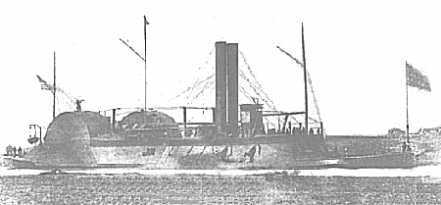
Eastport was the only Naval vessel to fire on Fort DeRussy during the March 14, 1864
battle. She "fired a short-
Eastport continued upriver after the fort's capture, and was scuttled by the Union Navy near Montgomery after striking a Confederate mine. The Edward F. Dix snagged on her wreckage at the end of the War, and the remains of the two boats lie intertwined to this day.
Eastport was 280 feet long, and drew a little over 6 feet of water. She was
armed with four 9-
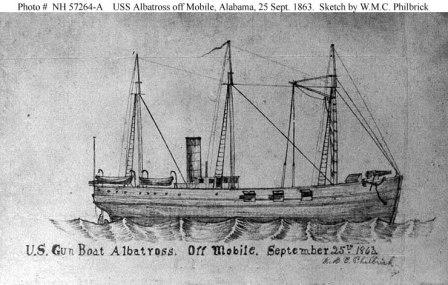
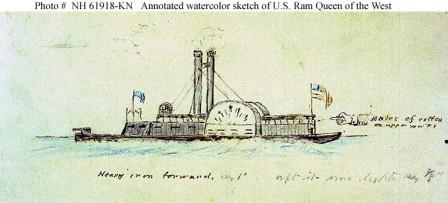
Osage, a sternwheel single-
Osage was 180 feet long by 45 feet wide, and drew 4.5 feet of water. She was
armed with two 11-
Of significant note is that the Osage was the first naval vessel ever to us a periscope to aim a weapon in time of war. This occurred up the Red River at Blair’s Landing in Red River Parish, and resulted in the death of Confederate General Tom Greene and a lot of his men.
USS Fort Hindman (tinclad #13)
Fort Hindman was one of the four naval vessels present at the capture of Fort DeRussy in 1864. She was the vessel that carried the captured Confederates from the fort to Baton Rouge. She was also one of the boats that made the first pass up Red River in 1865 when the War ended.
Fort Hindman was a side-
USS Cricket (tinclad #6)
Cricket played a big role during the Red River Campaign, serving as Admiral
Porter's flagship in the river above Alexandria (Black Hawk drew 6.5 feet of water,
Cricket only 4, hence the change in flagships). She was sternwheeler, 154 feet long
by 28 feet wide. According to Silverstone, she was armed with six 24-
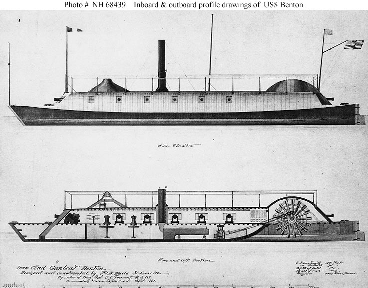
USS Essex (ironclad)
USS Dahlia (tug)
USS Black Hawk (large tinclad)
USS Lexington (timberclad)
USS Ouachita (large tinclad)
USS General Price (timberclad)
USS Fern (tug)
USS Carondelet (City Class ironclad)
USS Chillicothe (ironclad)
USS Choctaw (ironclad)
USS Lafayette (ironclad)
USS Louisville (City Class ironclad)
USS Mound City (City Class ironclad)
USS Pittsburg (City Class ironclad)
USS Neosho (monitor)
USS Ozark (monitor)
USS General Bragg (timberclad)
USS Judge Torrance (ordnance steamer)
The ordnance steamer Judge Torrance (or Torrence?) was a sidewheeler, 180 feet long by 30 feet wide, drafting 7’ 6”. Her name was changed to Amazon after the War, and she snagged and sank in 1868.
USS Samson (floating machine/blacksmith shop)
Samson (or possibly Sampson) was originally a ram, but served as a floating
blacksmith shop during her time on Red River. She also towed a carpenter shop, so
she seems to have been the fleet’s multi-
USS Woodford (hospital boat)
Woodford was a sidewheeler, 221 feet long by 34 feet wide, with a draft of just a hair over 6 feet. She was used as a hospital ship, and sank when she was caught on the rapids at Alexandria during the Red River Campaign.
The ram Avenger was engaged at Fort DeRussy in May, 1864, when she shelled
Confederate troops near the fort on several occasions. The boat was 181 feet long
and 41 feet wide, and drew 9’ 6”. She was armed with a 100-
USS Naiad (tinclad #53)
USS Nymph (tinclad #54)
USS Covington (tinclad #25)
The sidewheel tinclad Covington was 126 feet long and 37 feet wide, with a hull depth of 6’ 6”. She was active around Fort DeRussy in the latter part of the Red River Campaign. She was attacked at Egg Bend on May 5, 1864, along with the tinclad Signal, while escorting the steamer John Warner past the Confederate batteries there. After being run ashore on the north bank, her guns were spiked and she was burned to prevent capture.
USS Signal (tinclad #8)
USS St. Clair (tinclad #19)
USS Forest Rose (tinclad #9)
USS Meteor (tinclad #44)
The tinclad Meteor – 156 feet by 34 feet, with a 4’3” draft, armed with
two 32-
USS Tallahatchie (tinclad #46)
Sternwheel tinclad, armed with two 32-
USS Thistle (tug)
Thistle was another tugboat that supported the Naval forces during the
Red River Expedition. She was known to have carried (and used) a 12-
USS William H. Brown (dispatch vessel)
USS Brown, as she was more commonly known, was a 230 feet long by 26 feet wide
sternwheeler, and was armed with two 12-
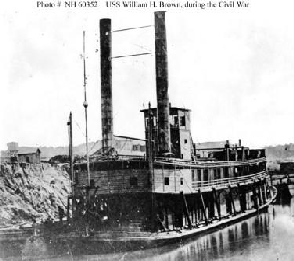
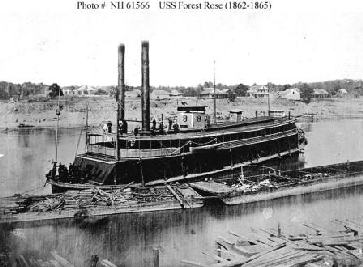
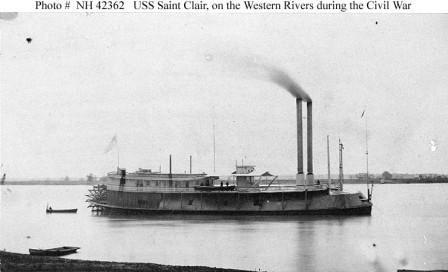
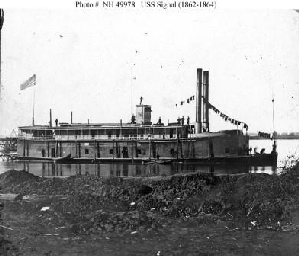
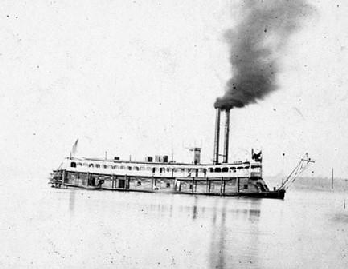
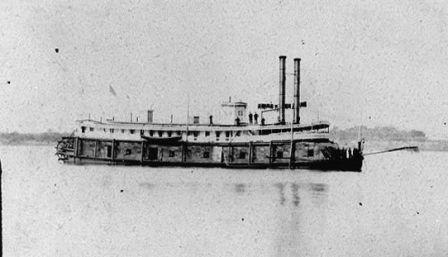
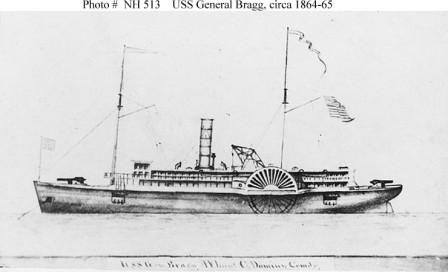
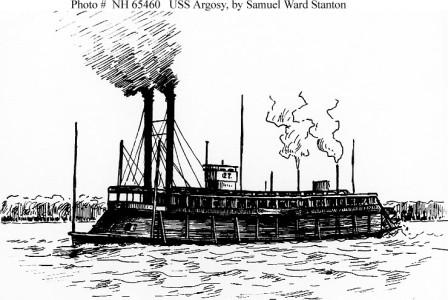
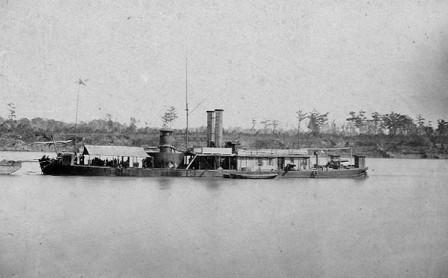
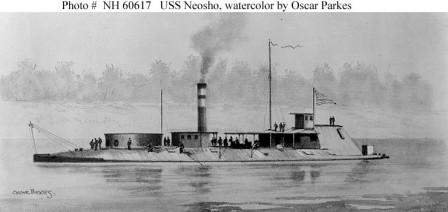
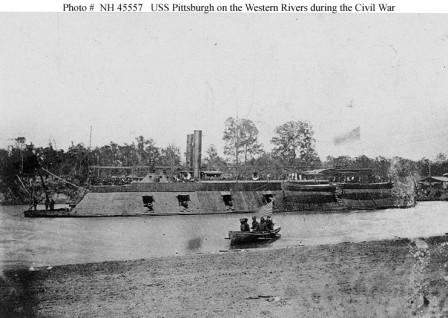
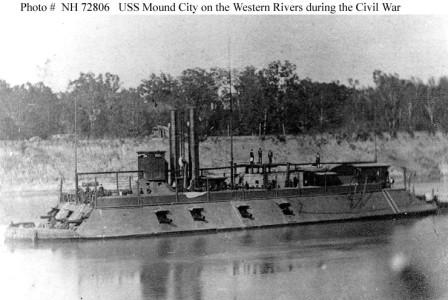

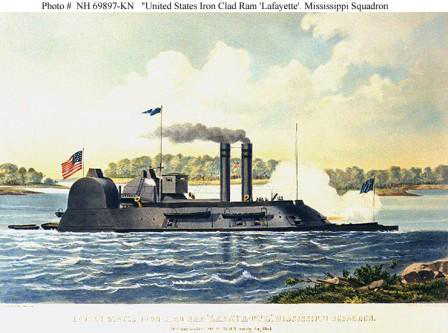
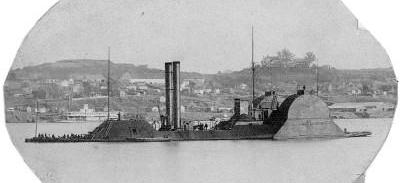
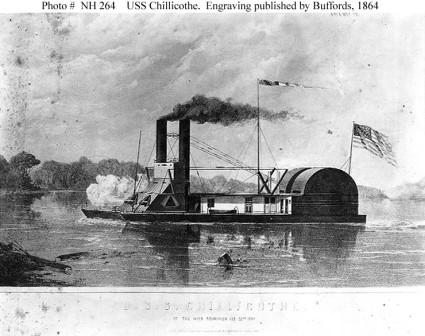
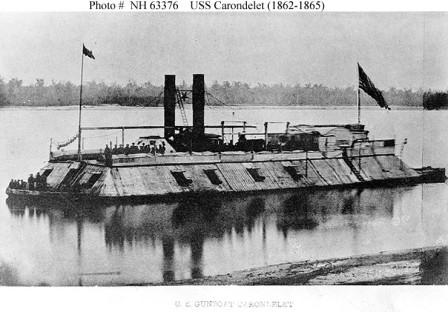
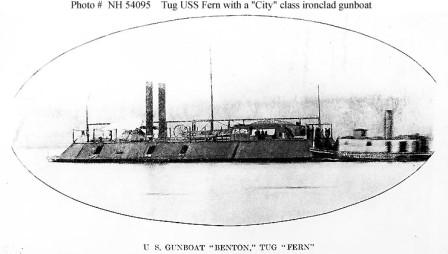
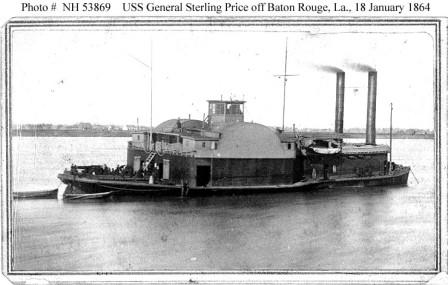
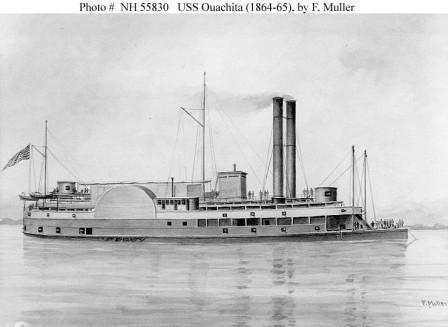
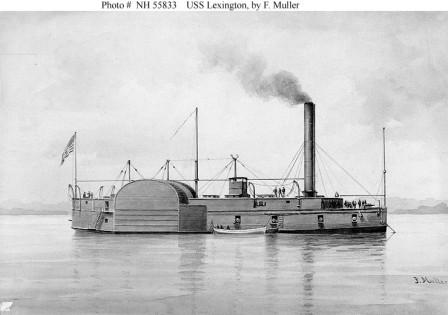
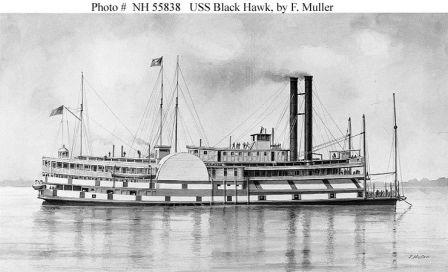
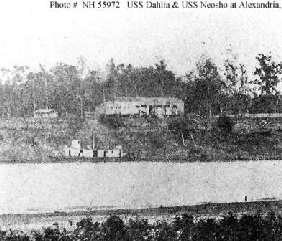
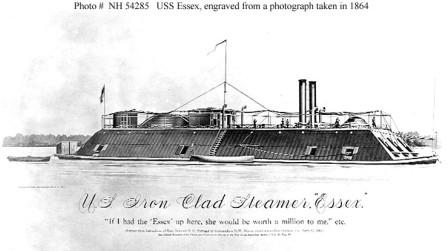
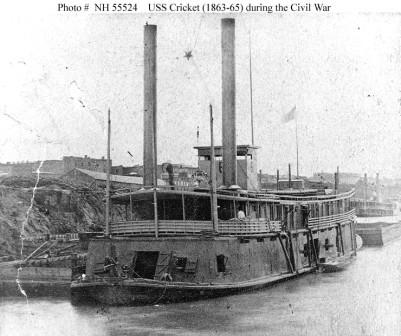
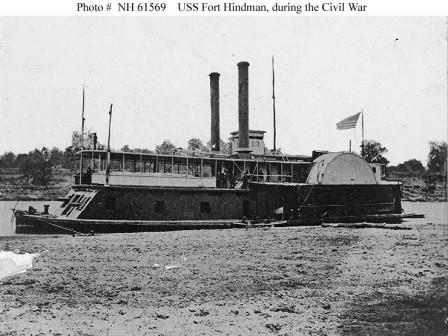
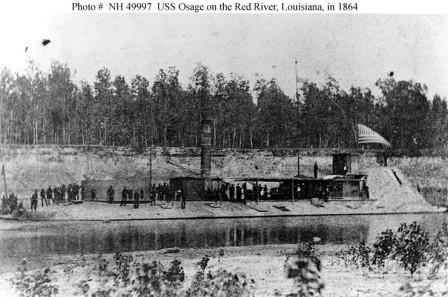
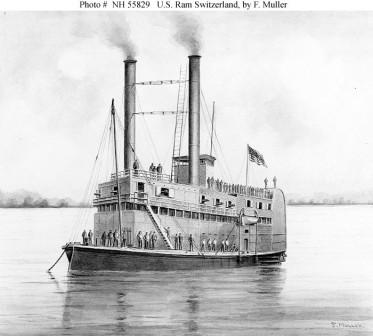
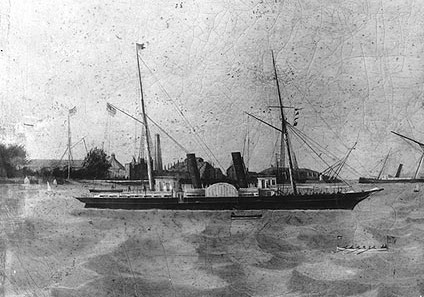
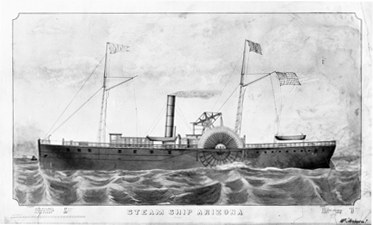
Benton was involved in the destruction of Fort DeRussy in May of 1863, and was
at the fort again during the first two weeks of the Red River Campaign in March of
1864. She left the fort in response to the attack on Fort Pillow, Tennessee. The
boat was 202 feet long and 72 feet wide, with a draft of 9 feet. She carried five
casemated guns on each side, with a four-
Of all the Union gunboats, Essex spent the most time at Fort DeRussy. A
converted river ferry, she was heavy and sluggish, but formidably armed and armored.
Like Benton, she was heavily involved in the destruction of the fort and the removal
of cotton from the area during the Red River Campaign. Different sources give her
different dimensions, but according to Silverstone, she was 159 feet long by 47 wide,
with a draft of 6 feet. She was notoriously slow – due in no small part to her 3”iron-
What can you say about a tugboat? She moved coal barges and such around,
and helped the gunboats maneuver in tight spots. Dahlia and Fern were a couple of
unsung workhorses in the Naval story of the Red River Campaign. And one entry in
the USS Neosho logbook indicates that Dahlia probably had at least one 12-
There were two Black Hawks in the Red River during the Red River Campaign. The steamer Black Hawk was General Banks’ flagship. The large tinclad Black Hawk was Admiral Porter’s flagship. As can be imagined, this leads to a lot of confusion.
The large tin-
Lexington was a sidewheel timberclad gunboat, 178 feet long by 37 feet
wide, drawing 6 feet. She carried two 8-
Prior to her capture, the USS Ouachita was the Confederate steamer Louisville,
and in that capacity she passed by Fort DeRussy at least once in 1863. She was back
at the fort as a large US Navy sidewheel tinclad in 1864, and again in 1865 at the
end of the War. The heavily armed boat carried five 30-
The sidewheel ram General Price came up the Red River in both 1863 and
1864. Formerly a Confederate boat, she was sunk at the Battle of Memphis in 1862,
after which she was raised and put into Union service. She was 180 feet long, 30
feet wide, and drew either 9 or 13 feet, depending on which source you reference.
(She seems to have either had a deep draft, or a very deep draft.) In 1863, she carried
four 9-
She was a tugboat. She moved coal barges and assisted the larger boats in maneuvering in tight areas and getting back afloat when they ran aground in the shallow river.
USS Carondelet was one of the “City” class ironclads, a “Pook turtle.”
She passed in front of Fort DeRussy twice during the Red River Campaign, but spent
no real time there. She was 176 feet long and 52 feet wide, and drew 6’ 6”. Her armament
consisted of two 100-
Like the Carondelet, the only time Chillicothe was at Fort DeRussy was
when she passed up Red River at the start of the Red River Campaign, and down at
the end. She was a sidewheel propelled ironclad boat, 159’ by 46’, with nearly 7
feet of draft, carrying two 11-
The sidewheel ironclad Choctaw was a formidable looking vessel. It was
one of the few big ironclads that spent any appreciable amount of time at the fort.
Choctaw was at the fort for several days toward the end of the Red River Campaign.
She was 260 feet long and 45 feet wide, and drew 8 feet of water. She was armed with
one 100-
Lafayette was very similar in appearance to Choctaw. She was 20 feet longer,
though, and while she carried the same combination of rubber/iron armor, hers was
twice as thick. Her firepower was also heavier – two 11-
Louisville was one of the four City class gunboats that participated in
the Red River Campaign. Like her sisters, she was 175 feet long by 51 feet wide,
and drew 6 feet. In 1864, she carried one 100-
Mound City was another of the City class gunboats in the Red River Campaign.
She spent most of the Campaign above the falls. She was armed with one 100-
Pittsburg was the last of the City class gunboats in the Red River Campaign.
She also spent most of her time above the falls. She carried one 100-
Neosho was a stern-
Neosho was armed with two 11-
Ozark was a monitor, but of a unique and peculiar design. Some of her guns
were in her forward turret, others in the aft casemate, and she was propelled by
two screws, rather than the standard paddlewheel. She carried two 11-
Argosy was a sternwheel tinclad, 156 feet long by 33 feet wide, with a
draft of 4 and a half feet. She spent quite a bit of time at the fort, and shelled
the place on a regular basis, during the latter part of the Red River Campaign. She
was armed with two 32-
USS Gazelle (tinclad #50)
Gazelle was a sidewheel tinclad. She passed Fort DeRussy going upriver
and coming down at the end of the Red River Campaign, but spent very little time
at the fort itself. She was 135 feet long by 23 feet wide, with a draft of 5 feet,
and carried six 12-
USS Juliet (tinclad #4)
The sternwheel tinclad Juliet passed by the fort going in and coming out
of the Red River Campaign, but all of her active service was upriver. She was 155
feet long by 30 feet wide, with a draft of 5 feet, and armed with six 24-
USS Little Rebel (tinclad #16)
Little Rebel was a peculiar tinclad, in that she was not a paddle-
1865
The sidewheeler General Bragg was unusual in appearance for a river gunboat,
having an exposed walking beam. She was 208’ by 33’, with a 12’ draft, and armed
with one 30-
The sternwheel tinclad Naiad was also engaged for a short time in the actions
against Confederate snipers at Fort DeRussy at the end of the Red River Campaign.
Naiad was 157 feet long, 30 feet wide, and drew 4’ 6”. She was armed with eight
24-
Nymph was another sternwheeled tinclad, and she was also engaged at Fort
DeRussy toward the end of the Red River Campaign. She was 161 feet long, 30 feet
wide, and drew 5 feet. She was armed with twelve 24-
Signal was a sternwheel tinclad, 157 feet long, 29 feet wide, with a draft
of a little over 5 feet. She was armed with two 32-
St. Clair arrived in the Red River toward the end of the Red River Campaign.
She was frequently fired into by southern snipers, and was never hesitant to return
the compliment. The sternwheeler was 156 feet long by 32 feet wide, and only drew
2’4”. During her time on Red River, she carried two 24-
There is a well-
Forest Rose was 155 feet long by 32 feet wide, with a five foot draft.
She was armed with two 30-